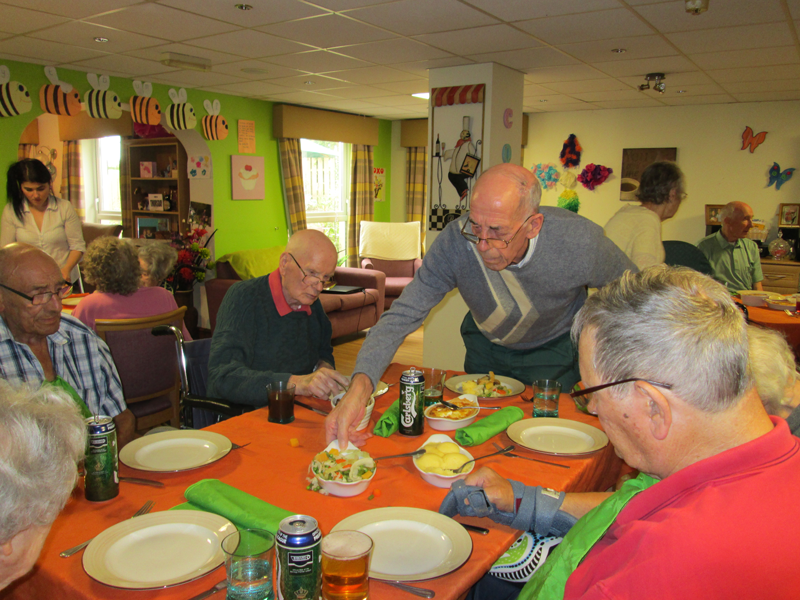*Register now for the November 15 Care to Chat on the Butterfly Model of Dementia Care, and a workshop with David Sheard.*
I long, as does every human being, to be at home, wherever I find myself
Maya Angelou
Generally the care home sector has accepted that people need to live in homes and not hospitals. Prison-like homes with restraint, locked “units” and staff looking like guards are increasingly being consigned to the past. Yet the debate around the “hotel model” of dementia care rages on.
Care providers seem divided on the merits of luxury hotel trappings and whether in dementia care this really creates the feeling of being at home. More priority continues to be given to presenting an external image “for sale” to relatives, who are seen as buying care for their older family members in a sea of confusion about what “outstanding” looks, sounds and feels like.
In 2006, Steve Shields and LaVrene Norton, in the USA, began strongly advocating for a household model of care, stating: “We’re building home, it’s a very easy concept. Yet it is a seemingly difficult one for the long-term care community to grasp. We’re building home. It’s just that simple.”
However, in 2017, it’s clearly not simple after all. Shields and Norton’s household model identified three components that support a home – renewal of the spirit, reframing the organisation and renovating it into home.

The movement to real inclusion of people living with a dementia has made headway with an acceptance overall that people become more feeling beings than thinking beings and need to feel reached and connected with.
Reframing care organisations culturally with congruent strategic and operational goals has proved difficult. Top-down aspirations of culture change, dementia design and person-centred care have turned out to be elusive in a largely private equity driven sector, where it seems shareholder returns have not been in synch with new models of care. In consequence, old architectural models of design have been reinforced because the culture of care has not been the strategic and operational driving force.
Renovating care homes into “home” has proved even more difficult where no academic, professional or sector agreement exists on what this is. Yet the feeling of home is quite simple, as the Lack Family pop group sing:
The feeling of home
The warmth of the house
The light of the candle
The evening glows
Take me into your arms
Let me make you some tea
We’ll cosy in and watch TV
The gleam of the fire
The sound of the wind
The blankets and pillows to settle in.
Households or units?
Just as the true meaning of “person centred” has been in danger of becoming institutionalised to refer to all care, regardless of its grounding in true person-centredness, so too the newest “in” term. This term is “household model of care,” which is at risk of referring to any care home where group living is provided even if this involves dividing the home up into “units”. No consensus exists about what criteria a real household model of care has to satisfy and a range of debates exist.
These debates are fascinating in that they expose deep-seated values, beliefs and feelings about what a household is, what makes an environment feel like home, what engaging environments consist of, and what role colour and what I call the “stuff of life” have to play in this. Briefly, I would define the stuff of life – or the “stuff” – as the meaningful objects that can be placed in care home environments for people to engage with, and which fill up the concept of “being at home” and bring the world closer to the people who live there.
Butterfly Household Model
The Butterfly Household Model of Care is a comprehensive culture change model (Sheard 2011).* Features of this model like attached leadership, emotional intelligence, house leaders and housekeepers, new culture nursing, meals as social occasions, and meaningful occupations are the most important. But the environment plays a major assisting role in enabling culture features like these to work. Our Butterfly Homes are well known to have various features relating to the environment:
• small domestic households of 8-12 people with front doors • matched households and matched environments grouping people together at a similar point of experience of a dementia
• combined lounge/diners to prevent unnecessary room division and “herding” of people
• open access kitchens encouraging domestic living
• heightened colour to create light, vibrancy and energy matched to people’s point of dementia • sections of colour to break up household areas and to create focal attention points
• engaging walls celebrating and telling the story of people’s lives within their house
• personalised bedroom doors aiding orientation and emphasising the depth of people’s lives
• Filled-up environments with all the “stuff of life” personalised to people living there
• Open shelving to create interest and smaller engaging areas in buildings not automatically lending themselves to households
• 24-hour visible and available snack food in appropriate cabinets where people can help themselves
• “life areas” emphasising DIY, a nursery, dressing up – the busyness of life
• themes on walls linked to people’s past lives – domesticity , family , work, travels and achievements
• removal of all “them and us” features with no staff and service notices within the households
• giving trollies and carts a more domestic facelift
• seeking staff to wear clothing that is personal and adds a sense of engagement to the environment
• balancing stimulating areas of the household with soothing areas
• ensuring dining tables like staff are engaging, colourful and attractive with “the stuff of life” encouraging a social experience and mounds of conversation
• Bringing the garden outside closer to the windows of the households
• Overall, creating an engaging environment that promotes life, energy, memories and people being reached.
Yet these features are far from the accepted wisdom. Just as we have deliberated for 20 years about person-centred care, so too are we at risk of replicating these debates in relation to households. So what are the key debates?
Environments: key debates
Care homes should be modelled on hospital-like environments
Response Sterile, empty, clinical environments in hospitals are provided for purposes of high quality acute care where people leave and return to their own homes. The emptiness in care homes modelled on hospitals prevents spontaneity and shuts people down, leading them to live in boredom and lethargy, staring into space much of the time. Care homes are not hospitals but places for people to live and feel alive.
Families like care homes to look like hotels and like hospitals
Response Families only know what they know and, in their mass of feelings of loss, guilt and regret, want to find and purchase the very best care they can for their relative. But they have often been mistakenly led to believe that this is a mixture of a hospital with hotel quality features and prison-like security. Once families know what good quality dementia care really looks, sounds and feels like, there is a hunger and a high demand for care homes where they can see their relative genuinely living in the moment.
Filling up the environment just creates clutter
Response Providing sterile, clinical, empty, brown, cream or magnolia painted environments is part of a malignant social psychology of care. Filling up the environment is only clutter if this is done in a random and disorganized way. The stuff of life is not clutter; it should be matched to individual people’s lives. If a stranger arrived at the household and had just 30 minutes to walk around, could they confidently tell the story of people’s lives from looking at all the stuff there? This is the key indicator that the selection of stuff is meaningful.
Our homes are not filled up so excessively
Response We are not creating homes for us but instead for people with perceptual and 3D disabilities, who cannot easily access in the same way as we can all the stuff of life that is available out in the external world. The filling up is about creating a microcosm of interest, objects and triggers giving a message to people that they are still part of a full life which has been brought to them.
The stuff of life contradicts dementia design ideas
Response Much of the emphasis on dementia design has been on improving architecture, orientation, way-finding and recognition, including more appropriate bathrooms and toilets. These ideas are all included and consistent with the Butterfly Household Model. Equally, those who advocate some of the new dementia design ideas state that people living with a dementia need routine and order and that surrounding people with objects of interest – the stuff of life – contradicts this by creating confusing environments.
But this is actually an example of professionals themselves feeling confused. Certainly, people living with a dementia in the early stages do require routine and order to enable them to have the feeling of holding on in life. Therefore, a household for people with early dementia would reflect this. Introduction of the “stuff” increasingly occurs as people move into a different reality, where facts, logic, reason and order become more meaningless and where it is more important to provide people opportunities to live in the moment surrounded by positive environments.
Dementia design ideas risk creating a new form of institutionalisation when focused too much on architecture and not enough on operational culture and the feeling of being at home. Balance is also required in providing vibrant, colourful and engaging environments.
Filling up household environments is not compatible with fire service regulations
Response Fire services have been used to regulating care homes with long institutional corridors like hospitals and are unfamiliar with the Household Model of Care.
Once fire services are engaged in the debate on households and as long as care homes don’t break regulations on fire doors and fire break walls, we have found more positive debate can be held. Areas to agree on are the use of fire retardant spraying, percentage use of combustibles and non-combustibles, and how people in households can be encouraged to exit faster using the stuff of life to orientate themselves rather than trying to exit speedily down long empty corridors.
The “stuff” does not adhere to infection control requirements
Response An over-reliance on infection control procedures while not measuring the ill-being that can arise from empty, sterile environments and not risk-assessing the emotional harm caused by these is the real debate.
It is possible to adhere to infection control procedures by having a clear policy on hygiene checks and replacing the stuff in environments on a regular basis.
The stuff is placed too close to people.
Response Living in an empty environment leads to expressions of feelings which can be misinterpreted as “behaviours”. These are caused by the environment giving people feelings of having an empty life. Indeed, the emptiness in care homes is a metaphor for how people living with a dementia can be seen to be “empty people”.
For someone experiencing dementia and its progression, the world comes in closer and closer and even engaging objects placed around the edges of the room can seem a million miles away.
Placing objects in saddle bags, on tables close by and even in the pockets of aprons worn by staff changes the metaphor of emptiness. People are given the message that their lives are still full of things to touch, see, and fiddle and be busy with (Knocker 2015).
The stuff is just not smart enough to “sell” the care home to relatives
Response It is natural for people living in the home, if the stuff is really working, for them to move it around, carry it, take it into their own rooms or put it in unusual places.
Left to its own devices over time, it could look disorganised. But it is perfectly possible for the stuff of life to look smart, attractive and engaging, and be compatible with a “high end” look too. It requires staff as the day begins to, in effect, arrange the household as a theatre stage so that there is a sense that the stuff has been organised to create moments in people’s lives. Once families see and understand it, there is a high demand for this approach.
The model doesn’t fit with my professional beliefs
Response Since when have empty, sterile environments fitted with anyone’s belief in what it means to be a human being? Human beings who need, in Tom Kitwood’s words, love, comfort, security, attachment and belonging? In the end, it is not for professionals to decide on environments, the stuff or what works for people living with a dementia. It is up to people living with a dementia themselves. Of course, left in empty environments they are stripped of any decision-making ability. The filling up of environments is about offering people living with a dementia real choice and autonomy to be who they want to be with whatever makes sense and connects with them.
Colour doesn’t really matter in dementia care
Response Butterfly homes are known for their use of heightened, vibrant colour, two to three shades up on colour charts from what many professionals are comfortable with. The use of these colours recognises that people living with a dementia struggle to differentiate between soft pastel colours. Colour creates easier room division but, more importantly, it is a powerful statement to everyone that the household is all about injecting life. As a result, colour usage is a key driver in breaking the old culture of care and creating a new message of everyone really flourishing together (Bewert 2016).
Butterfly model of colour
Our guiding principles on colour in households are briefly these:
• Match colour choices to the “matched households”, ie colours for people living with an early dementia would be in the same range of colours as anyone else uses to decorate their own home; colours for people living in a “different reality” would be heightened and vibrant as described. A household for people with repetitive expressions or in later stage dementia would tend towards the more soothing spectrum of colours while still avoiding pale pastels.
• Involve families, staff and people living in the home in the colour choice, once they understand the rationale behind it. Interestingly, people living with a dementia will often choose more vibrant colours and require no prior explanation to do so.
• Involve people living in the household in choosing the colour of their bedroom door or the area surrounding it. It might link back to a door colour choice in their past lives.
• Move two or three shades up the paint colour charts than would seem natural, i.e. choose a more vibrant shade.
• Avoid placing colours side by side in a household environment that are next to each other on the colour spectrum. Place one colour next to a contrasting colour to differentiate areas within the household.
• Our evidence is that households which do not use colours in these ways have higher levels of illbeing among the people who live in them. Some academics would question this relationship between environment, colours and health care outcomes, but our experience of qualitative audits in 750 care homes indicate that this relationship does exist.
Summary
The search for academic evidence to allay professional fears about moving into a more confident, vibrant household model is in our view mistaken. Qualitative observation in many household models, including the Butterfly Household Model of Care, already shows that wellbeing improves while expressions of feelings linked to behaviours, sedation and the use of antipsychotic medication are all reduced.
While this evidence cannot be directly linked as a cause to colour and filling up care home environments, there is certainly no evidence that these approaches are obstructing the implementation of successful new models of care or doing what clinical care home environments often do. That is, increasing levels of ill-being and keeping people in boredom and lethargy.
In other words, we know already what lack of colour and empty environments have created and we are seeing, hearing and feeling what addressing this can result in. In Maya Angelou’s words again:
The ache for home lives in all of us, the safe place where we can go as we are and not be questioned.
Dr. David Sheard is CEO and founder of Dementia Care Matters and visiting senior fellow at the University of Surrey, UK.
This article was originally published in The Journal of Dementia Care.





